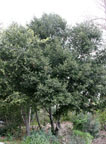15. Quercus agrifolia “Coast Live Oak” Weht
Food: The Oak is the central food plant for the Tongva. In autumn, tribal units would travel to specified groves to gather the ripe acorns.
The acorn was the major food source for the Tongva. Each family was responsible for its own oak grove and for the care and maintenance of the family grove.
As needed, the acorns would be dried, cracked open, and peeled. The acorn meat “Chemeshkwar” would be pounded into a fine “meal”. Then a long leaching process would eliminate the toxic tannin and prepare the ground, leached “meal” for the cooking process which produced acorn porridge “Wewish” or the meal could be baked into small bread cakes “Peshkae”.
Medicinal: The oak gall was dried, then ground into a fine powder and used for eye infections.
Spiritual: Elaborate ceremonies, dances, and songs celebrated the acorns and the gathering times. The galls were also painted and decorated and attached to head sticks for ritual dances.
Tree, evergreen.
Q. agrifolia blossoms March to April; acorns mature in one year.
Q. agrifolia common in valleys and on not too dry slopes below 3000 ft; Southern Oak woodlands, Foothill woodlands and Catalina.
Spanish: Encino
